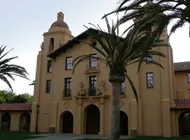Table of Contents
The ASSU executive has $17,282 to disperse from their discretionary fund, but it has yet to set specific earmarked amounts for much of the money.
Distribution of the discretionary funds is determined solely by the ASSU executive. This year, the executive is maintaining its flexible approach to allocating money from that account. The majority of the discretionary budget, around $10,000, will be allocated to executive action grants, according to Stewart Macgregor-Dennis, ASSU vice-president. These grants are typically awarded to students who plan events and initiatives that could not be completed with other sources of funding. The amount spent this year is similar to the amount spent for executive action grants last year.
The next largest portion of the discretionary budget is earmarked for the Stanford Showcase. Macgregor-Dennis called it “a capstone” and an “umbrella event,” featuring a service summit, a concert, and guest speakers. The summit will be conducted in collaboration with many groups on campus. While the executives do not currently know the specific amount that will be used for the Stanford Showcase, Macgregor-Dennis gave an estimate of a little over $4,000.
The remaining $3,000 or so left in the discretionary budget will largely go to funding cabinet initiatives or other purposes like student events, according to Macgregor-Dennis.
While cabinet divisions do largely rely on funding from the discretionary fund, they can also pursue outside funding by working with other campus organizations or university departments and by applying for student funding.
According to Macgregor-Dennis, some funds will be earmarked for use by specific divisions within the executive branch and cabinet, but “a portion of [the executive discretionary budget] will be for what the item says it is and is discretionary for the rest of the year,” he said. “We’re looking to spend it at a relatively equal rate throughout the year.”
Some of these funds have already been approved under this fund-as-you-go scheme for executive initiatives, but the executive could not provide detail about these expenditures.
The ASSU senate approves the annual ASSU budget, but only has oversight over the amount given to the discretionary fund, not the specific use of the money.
“I, as a member of the Undergraduate Senate, do not have any say in how or when that money is spent,” explained Alon Elhanan, an ASSU senator, in an email to The Review. He added that the Senate’s only way to check how the discretionary budget is spent is through executive reports.
According to Senator Dan Ashton, the Senate does not yet know how the discretionary funds will be spent. Ashton said that he personally supported the idea of a “soft budget” over a more formally structured one, although he agrees that a general outline would be good for transparency.
Elhanan, on the other hand, said that he personally thinks a more transparent description of how the discretionary money will be spent would be “better for the student body.” But he also recognized the need to maintain “wiggle room” to account for the development of new initiatives.
Reacting to the current “soft” or fund-as-you-go budget format, Ian Chan, an ASSU senator, wrote in an email to the Review, “The rationale provided to us from the Executive is that previously earmarked budgets have not given the cabinet enough flexibility as the year went by.” He continued, “different chairs and initiatives were either over-budgeted or under-budgeted.”
Chan said that he believed the more flexible model was “worth trying” despite it’s possible lack in transparency, provided the Senate monitors and questions the executives on spending decisions.
Macgregor-Dennis explained that the ASSU has an answer to some of the transparency questions. The Division of Internal Review is the executive’s attempt at “transparency, accountability and financial dependability,” within the ASSU.
“Essentially, we’ll be doing full reporting, full analysis, and auditing and sending those results back to the students,” Macgregor-Dennis explained.





